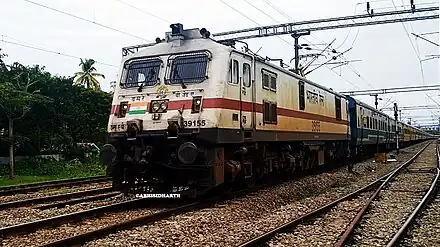| WAP-7 | |||||||||||||||||||||||||||||||||||||||||
|---|---|---|---|---|---|---|---|---|---|---|---|---|---|---|---|---|---|---|---|---|---|---|---|---|---|---|---|---|---|---|---|---|---|---|---|---|---|---|---|---|---|
 CLW made WAP-7 rest at CLW yard | |||||||||||||||||||||||||||||||||||||||||
| |||||||||||||||||||||||||||||||||||||||||
| |||||||||||||||||||||||||||||||||||||||||
| |||||||||||||||||||||||||||||||||||||||||
| |||||||||||||||||||||||||||||||||||||||||
The Indian locomotive class WAP-7 is a class of 25 kV AC electric locomotives that was developed in 1999 by Chittaranjan Locomotive Works (CLW) for Indian Railways. The model name stands for broad gauge (W), AC Current (A), Passenger traffic (P) locomotive, 7th generation (7). They entered service in 2000. A total of 1532 WAP-7 have been built, with more units being built at CLW, Banaras Locomotive Works (BLW) and Patiala Locomotive Works (PLW).
The WAP-7 is the most successful locomotives of Indian Railways serving passenger trains for over 23 years. It is a passenger variant of the WAG-9 freight locomotive with a modified gear ratio to pull lighter loads at higher speeds. With an output of 6125HP, it is the most powerful passenger locomotive in the Indian Railways fleet, and the most numerous passenger locomotive in India. The WAP-7 is capable of hauling 24 coach trains at speeds 110–140 km/h (68–87 mph).
History
It is now largely used by Northern Railways (NR), South Central Railways (SCR), Central Railways (CR), South East Central Railways (SECR), South Eastern Railways (SER), West Central Railways (WCR), Eastern Railways (ER), Western Railways (WR), North Central Railways (NCR), South Western Railways (SWR), Southern Railways (SR), East Central Railways (ECR), East Coast Railways (ECoR), North Eastern Railways (NER), North Western Railways (NWR) etc. among other zones. As of October 2021, all of which are fitted with H-type transition couplers which are compatible with both screw coupling and centre-buffer coupling. In February 2017, Banaras Locomotive Works built their first WAP 7 class locomotive.[4]
In 2019, a variant of the WAP-7, designated the WAP-7HS, was introduced for higher speeds. The WAP-7HS has a max speed of 180 km/h (110 mph), and is capable of hauling a 24-car train at 160 km/h (99 mph) as opposed to the 140 km/h (87 mph) of the original. Indian Railways plans to use the WAP-7HS for Shatabdi, Rajdhani, and Duronto express trains. However, as of September 2022, it has not been confirmed if any others have been built, and the single completed WAP-7HS has stayed restricted to 130 km/h (81 mph).
Head-on Generation (HOG)

A main feature of Majority locomotives of this class is that they eliminate the need to have separate End on Generation (EOG) sets or DG (Diesel Generator) sets for supplying power to the train resulting in significant savings on maintenance and running costs. This technology, called HOG or "Head On Generation", transfers electric power from the loco's pantograph to the coaches instead of EOG where a power car equipped with diesel generator capable of generating adequate power of 3-phase 50 Hz 415 V / 750 V AC (called 'head-end power') is provided at either end of the train rake to supply power.[5][6][7]
Locomotive sheds
Gallery
 Howrah based WAP7 on lead with 02302 New Delhi - Howrah Rajdhani Express Special at Janai Road
Howrah based WAP7 on lead with 02302 New Delhi - Howrah Rajdhani Express Special at Janai Road LGD WAP-7 30306 at Bangalore
LGD WAP-7 30306 at Bangalore Vijayawada WAP-7 39155 with 12075 Kozhikode Main Thiruvananthapuram Central Jan Shatabdi Express Skipping Thuravoor Railway Station in Kerala.
Vijayawada WAP-7 39155 with 12075 Kozhikode Main Thiruvananthapuram Central Jan Shatabdi Express Skipping Thuravoor Railway Station in Kerala. New Delhi-Lucknow Tejas Express powered by WAP-7, standing at New Delhi.
New Delhi-Lucknow Tejas Express powered by WAP-7, standing at New Delhi._WAP-7.jpg.webp) WAP-7 #30261 charging on time running 22416 NDLS-VSKP A.P. A.C. Express.
WAP-7 #30261 charging on time running 22416 NDLS-VSKP A.P. A.C. Express. A Ghaziabad-based WAP-7 hauling the Bhubaneswar Rajdhani Express
A Ghaziabad-based WAP-7 hauling the Bhubaneswar Rajdhani Express WAP-7 with the Bangalore Rajdhani Express near Lingampally Railway Station
WAP-7 with the Bangalore Rajdhani Express near Lingampally Railway Station RPM based WAP-7
RPM based WAP-7 Jammu Tawi bound Humsafar Express leaving Kazipet Junction, hauled by VSKP WAP-7 No. 37062
Jammu Tawi bound Humsafar Express leaving Kazipet Junction, hauled by VSKP WAP-7 No. 37062 12737 Goutami Express at Moula-ali with a WAP-7 loco
12737 Goutami Express at Moula-ali with a WAP-7 loco Ghaziabad-based WAP-7 locomotive at Anand Vihar Terminal
Ghaziabad-based WAP-7 locomotive at Anand Vihar Terminal
See also
References
- ↑ "[IRFCA] Indian Railways FAQ - AC Electric Locomotives".
- ↑ "What are the specifications of WAP 7 HS?".
- ↑ "[IRFCA] Indian Railways FAQ - AC Electric Locomotives".
- ↑ "Brief History of DLW". Ministry of Railways, Government of India. Retrieved 30 December 2017.
- ↑ "Train had WAP-7 engine, 'black box' may reveal cause". Zee News. 9 August 2010. Retrieved 25 August 2012.
- ↑ "Recent Developments". Chittaranjan Locomotive Works. Retrieved 25 August 2012.
- ↑ "Development of Electric locomotive with Head On Generation (HOG) facility" (PDF). Indian Railways.
- ↑ "e-Locos".



